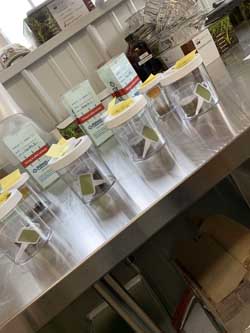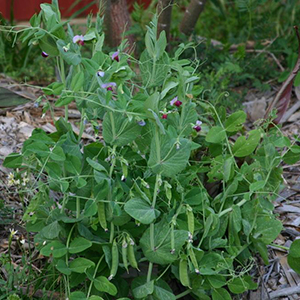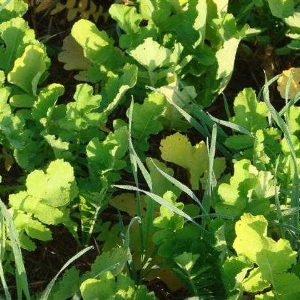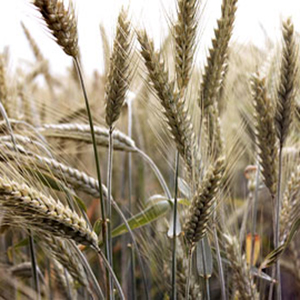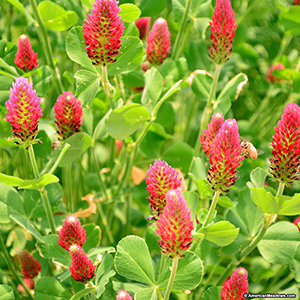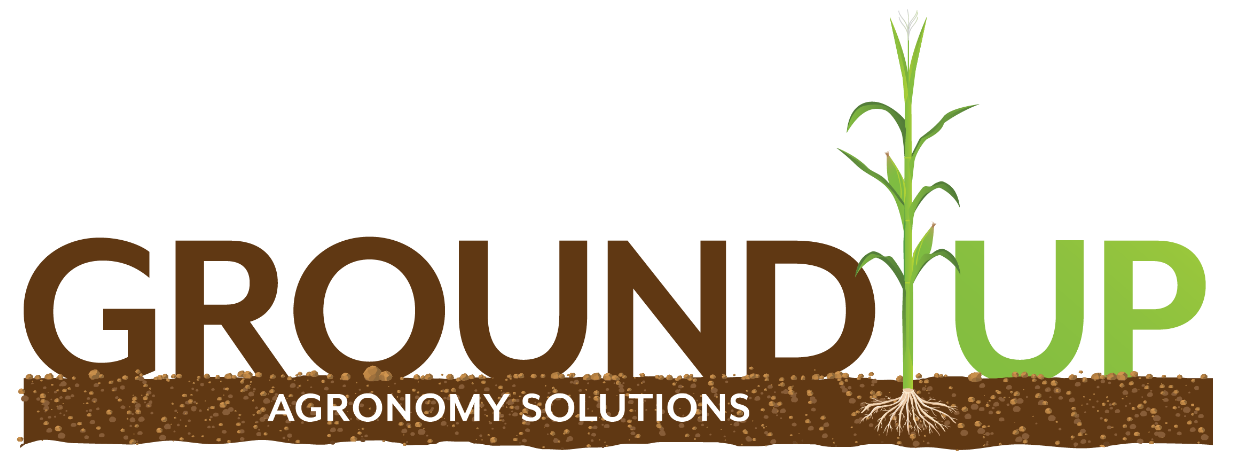
Will Take Care of Your Crop from the Ground Up
Agronomy
Using compiled data, straight from your fields, AgriVision Solutions provides quality agronomic advice that best suits your operation. Our goal is to maximize the profitability of our customers while implementing sustainable farming practices for future generations. Having a hands-on approach allows us to help your farming operation succeed by being on your farm, assessing your conditions, diagnosing your challenges, and providing you with a personalized solution specific to your operation’s needs.
We take pride in our soil and tissue sampling. AgriVision Solutions’ Certified Crop Advisors will review results with you, the grower, while making expert recommendations. Soil and tissue samples are taken at the farmer’s request. Samples are sent immediately to Midwest Laboratories for processing. Once AgriVision receives the results, a Soil Analysis Book is created for easy to understand information. Information found in the book is useful for optimizing plant growth and assist in solving soil related problems.
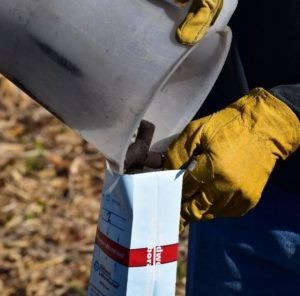

Grid
- Grid sampling provides additional control over nutrient loads leading to a sustainable system. It reveals how nutrients are distributed across the field. The more soil samples taken from a field, the better understanding we have of where the nutrients are available. Understanding the available nutrients, we can be confident that your fertilizer dollars are being used efficiently. Grid sampling allows us to prevent over-application of fertilizer in areas where nutrient levels are high. Grid Soil Analysis Book
Zone
- Do you manage high production areas the same as you do lower production areas within a field? Grouping areas within a field that have similar characteristics into management zones allows for more efficient application of inputs. Several samples are collected from each area and are combined into one bag for testing. Since we are identifying large areas with similar characteristics, there is a lesser need to pull many samples from large areas, which in turn provides better information at less cost. Zone Soil Analysis Book
Tissue
- Plant tissue analysis has become a valuable crop production tool. A plant tissue test will show the status of nutrients of the plants during the growing season. It detects unseen, hidden needs. Plant analysis can also supply information that confirms visual deficiency symptoms. Combining tissue and soil analysis, a tissue analysis will aid in determining the proper fertilizer applications to apply in order to balance the nutrient availability in the soil and the nutrient requirements of the crop. A tissue sample will identify the nutrient status of the following elements: nitrogen, phosphorus, potassium, magnesium, calcium, sulfur, sodium, iron, manganese, boron, copper, and zinc.
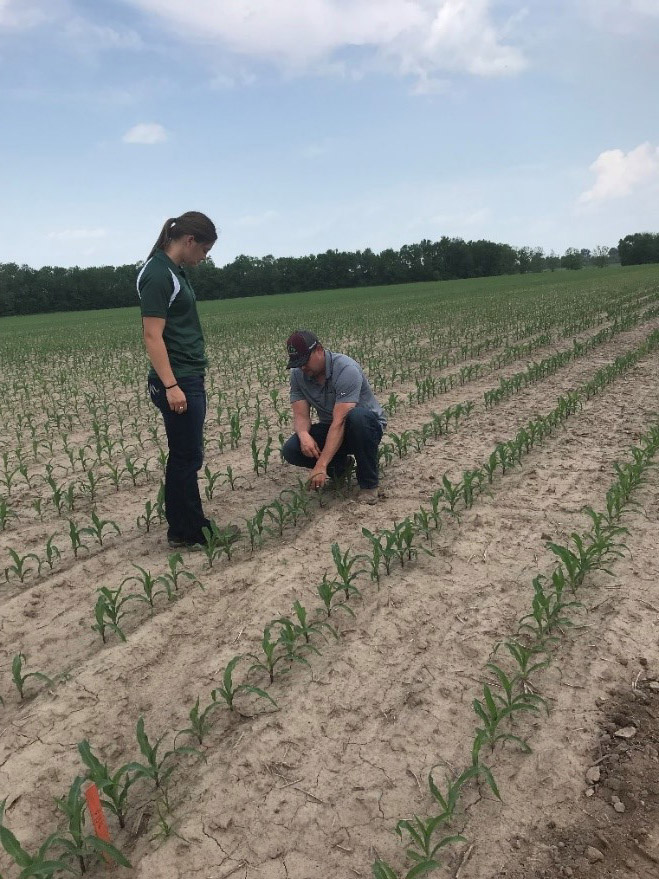
Our team can diagnose problems in your fields and offer advice.
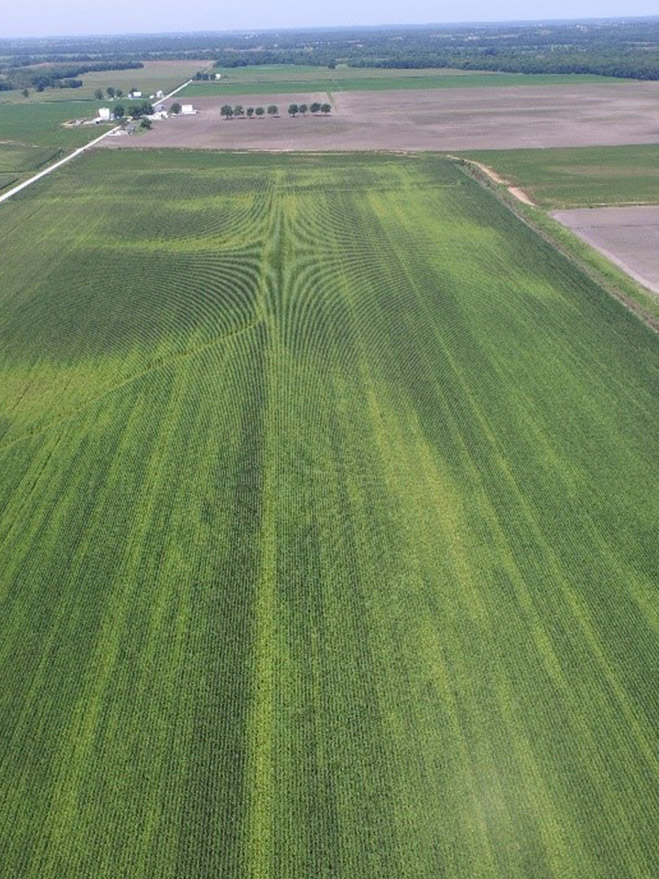
With the use of drones, our team can quickly see what areas of the field we need to take a closer look at.
Reports
- Scouting reports include everything agronomic, from stand counts, insect and weed identifications, disease identifications, and growth stages. If a report raises a concern, in field pictures of your crop progress and potential problems are available with detailed descriptions. Along with pictures there are GPS locations that allows you to know the exact place in the field where the information was recorded. These reports are emailed as PDF documents.
Essential Nutrients’ Roles
- Essential nutrients or elements are those that are required by plants to complete their life cycle. Macronutrients are required in large amounts, while micronutrients are required in much smaller amounts. Plants demand for nutrients gradually increases during the seedling stage, rapidly increases during vegetative growth and decreases again as reproductive growth dominates. During the seedling stage, plants are small and nutrient demand is small. As the plants become larger through the vegetative growth stages nutrient needs increase. Nutrient needs can be high in reproductive tissues, but much of that demand is met by redistribution of nutrients that are contained in vegetative tissues. Carbon, oxygen, and hydrogen are obtained by plants from carbon dioxide and water found in the air and soil.
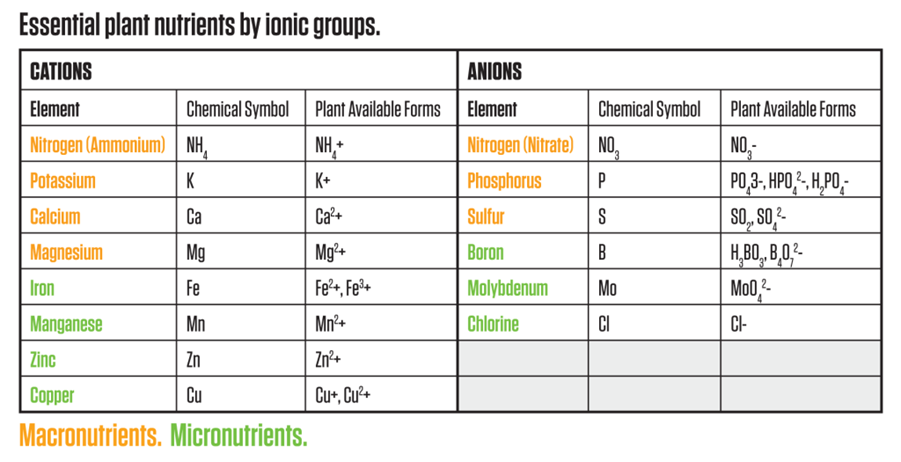
Hydrogen (H)
- Hydrogen, along with carbon and oxygen, are the three primary elements plants use in the largest amounts, and they perform as the building blocks for plant growth. Nearly all organic compounds contain hydrogen atoms, which explains why plants need the hydrogen they get from water molecules through photosynthesis. Hydrogen ions are important both for aiding proton gradients to help drive the electron transport chain in photosynthesis and for plant respiration. It also is necessary for building sugars and other key molecules to produce glucose for plant energy.
Carbon (C)
- Carbon is responsible for all life on earth. Plants take carbon dioxide from the air and use the carbon for energy, to help build biological compounds such as carbohydrates and proteins. Carbon is the primary energy source and building block for plant tissue. Plant residues, green manures and animal wastes can be significant sources of organic carbon in the soil.
Oxygen (O)
- Oxygen is responsible for cellular respiration in plants. Plants get oxygen by breaking down carbon dioxide during photosynthesis and end up releasing most of the oxygen as an unnecessary byproduct, saving a small portion for future energy. Only the leaves and stems of a plant acquire oxygen through photosynthesis. Roots of a plant are forced to take in oxygen from the environment through air spaces in the soil.
Nitrogen (N)
- Nitrogen is a key element in plant growth, it is found in all plant cells, proteins, hormones, and in chlorophyll. Nitrogen is a component of vitamins, amino acids, and energy systems within the plant, which form its proteins. Thus, it is directly responsible for increasing protein content in plants. Lack of nitrogen and chlorophyll means the plant will not utilize sunlight as an energy source to carry on essential functions such as nutrient uptake. When nitrogen is applied to the soil, it is converted to its mineral form, nitrate, the form in which plants take it up. Nitrate is very mobile in the soil and moves with soil water to root surfaces for plant absorption.
Phosphorus (P)
- Phosphorus aids in the transfer of energy from sunlight to plants, stimulates early root and plant growth, increased stalk and stem strength, and hastens maturity. The plant must access phosphorous to complete its normal production cycle. The highest levels of phosphorous in young plants are found in tissue at the growing point. As the crop matures, most of the phosphorous moves into the seeds, fruit, or both.

Potassium (K)
- Potassium is one of the essential nutrients that is taken up in significant amounts by crops. It is important for photosynthesis, food formation, protein synthesis, building cellulose and translocating sugars and starches. Ample amounts of potassium can increase root growth and improves drought tolerance. In addition to being less resistant to drought and extreme temperatures, plants lacking potassium are more susceptible to pests, diseases and nematode attacks. Potassium is vital to producing grains rich in starch.
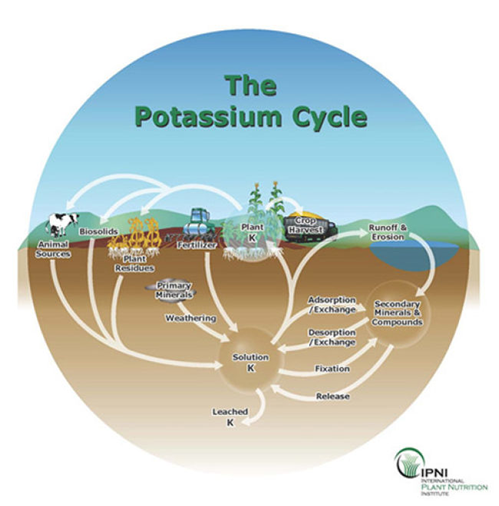
Calcium (Ca)
- Calcium is essential for root health, growth of new roots and root hairs, and the development of leaves. It is the stimulant for root and leaf development and affects uptake and activity of other nutrients. In acidic, sandy soils it is common for calcium deficiencies to occur because calcium leaches via rain or irrigation water. Calcium helps form the compounds that make up part of cell walls, which in turn, strengthen the plant structure. It builds yield indirectly by improving root growth conditions and stimulating microbial activity, molybdenum availability and uptake of other nutrients. It also aids in enable nitrogen fixing bacteria that form nodules on the roots of legumes to capture atmospheric nitrogen gas and convert it into a form plants can use.
Magnesium (Mg)
- Magnesium is a key component of chlorophyll, the green coloring material of plants, and is vital for the conversion of the sun’s energy to food for the plant (photosynthesis). It also aids in phosphate metabolism, plant respiration and the activation of many enzyme systems. Magnesium acts as a phosphorous carrier in plants and is required for better root formation resulting in better nutrient and water efficiency in plants. Magnesium is mobile within the plant and moves easily from older to younger tissues.
Sulfur (S)
- Sulfur is a constituent of amino acids in plant proteins and is involved in energy-producing processes in plants. Legumes need sulfur for efficient nitrogen fixation. Sulfur aids in seed production.
Iron (Fe)
- Iron is made of many compounds that regulate and promote growth. It is a component of many enzymes associated with energy transfer, nitrogen reduction and fixation, and lignin formation. Iron acts as an oxygen carrier in the nodules of legume roots and as a catalyst to chlorophyll formation. Deficiencies can be caused by an imbalance with other metals such as copper, manganese, and molybdenum. A plant deficient in iron will often display a pale green leaf color, with sharp distinction between green veins and yellow interveinal tissue.
Manganese (Mn)
- Manganese functions primarily as part of enzyme systems in plants. It accelerates germination and maturity while increasing the availability of phosphorus and calcium. Manganese plays a direct role in photosynthesis by aiding in chlorophyll synthesis. As a result of being very immobile in plants, deficiency symptoms appear first on younger leaves, with yellowing between the veins. Sometimes a series of brownish black specks appear. Although deficiencies are often associated with high soil pH, they may result from an imbalance with other nutrients such as calcium, magnesium, and iron.
Copper (Cu)
- Copper activates enzymes and catalyzes reactions in several plant-growth processes. Copper is the most immobile of the micronutrients. It is necessary to chlorophyll formation in plants and catalyzes several other plant reactions.
Zinc (Zn)
- Zinc was one of the first micronutrients recognized as essential for plants and the one most commonly limiting yields. Although required in small amounts, high yields are impossible without it. Zinc aids in the production of a plant hormone responsible for stem elongation and leaf expansion. Reduced zinc availability will cause shortening of internodes and stunted leaf growth. Since zinc is less mobile in the plant, deficiency symptoms first appear on younger leaves.
Boron (B)
- Boron helps with the formation of cell walls in rapid growing points within the plant, such as reproductive structures and improves seed set under stressful conditions. Boron deficiencies are more pronounced during drought periods, when root activity is restricted. Deficiency reduces the uptake of calcium and inhibits the plant’s ability to use it.
Molybdenum (Mo)
- Molybdenum is essential for bacteria and soil organisms to convert nitrogen in the air to soluble nitrogen compounds in the soil, so it is particularly needed by legumes. It is also essential in the formation of proteins from soluble nitrogen compounds.
Chlorine (Cl)
- Chlorine is taken up by plants as the chloride anion. It’s active in energy reactions in the plant and supports the transport of nutrients such as calcium, magnesium and potassium within the plant. It plays an important role in plants as they acclimate to changing water availability and the breakdown of water in the presence of sunlight. Chloride is a key component in stomatal regulation. Stomata regulates the release of moisture from plants so they can minimize water loss during stressful dry periods.
Nickel (Ni)
- Nickel is required in very small amounts, the critical level appearing to be about 1.1 parts per million. Nickel is necessary for the conversion of urea to ammonia in plant tissue, making it important in plant nitrogen metabolism.
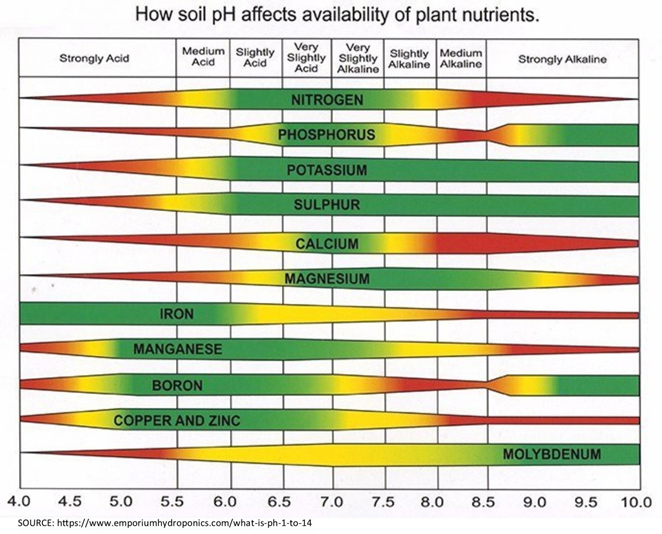
Soil Profile
- Cation Exchange Capacity is the total amount of cations that a soil can retain. The higher the soil CEC the greater the soil’s ability to store plant nutrients. CEC helps to explain why certain elements such as positively charged potassium, calcium, magnesium, and ammonium nitrogen, are not as easily leached from the soil as negatively charged ions, or anions, of nitrate nitrogen, sulfates, or chlorides. Cations adsorbed on the surface of soil colloids, and those contained in the soil solution, are available for plant use. Adsorbed cations, however, can be replaced by other cations present in the soil solution through the process of cation exchange. These replaced cations may then combine with an anion and be leached from the soil. The force by which cations are held by soil colloids will depend upon several factors. The smaller the cation and the less water it has adsorbed, generally the tighter the cation is held on the soil particles. Hydrogen ions, therefore, are more tightly held and more difficult to replace than larger and more hydrated cations such as ammonium, calcium, magnesium and potassium. Soils with high sand and silt content have lower percentage of clay and organic matter, and thus have lower CEC. This explains why coarse-textured soils require more frequent applications of lime and fertilizer.
- Organic matter is the fraction of the soil made up of anything that once lived, including plant and animal remains, cells and tissue, plant roots and soil microbes. It is a dynamic, changing resource that reflects the balance between addition of new organic matter and loss of organic matter already in the soil. To build up organic matter in the soil you need to maximize the addition of new organic materials and minimize losses from the soil.
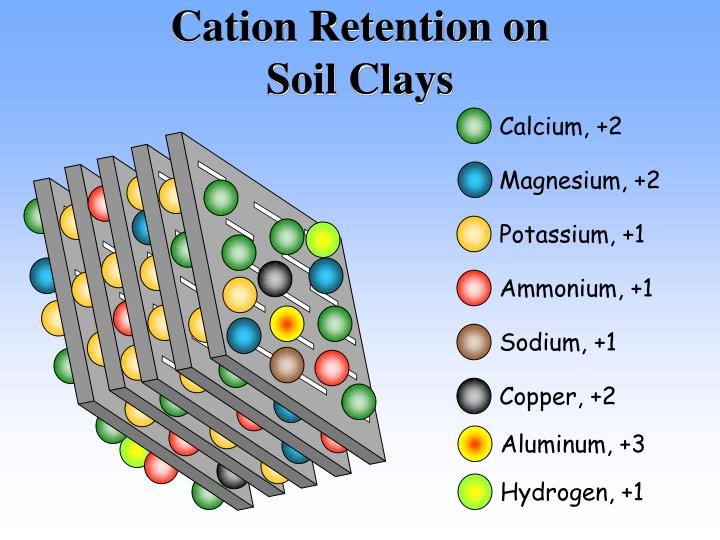
Why does organic matter decline?
- Erosion removes topsoil filled with organic matter.
- Some farming systems reduce the amount of new organic matter going into the soil.
- Cultivation mixes topsoil rich in organic matter with subsoil low in organic matter. It also breaks down soil aggregates and exposes previously protected organic matter to microbial activity.
- In warm wet conditions that encourage decomposition, organic matter in bare soils breaks down quickly.
- In some cases, increased quality of organic inputs provides more nitrogen for microbes and less hard-to-digest lignins, and this encourages faster breakdown.
Techniques to build organic matter
- As organic matter levels decline, the storage and supply of major plant nutrients such as nitrogen, phosphorus, and sulfur diminish. This reduces the potential for plant production. When plant production declines, there is less organic matter available for soil organisms, so their activity declines, leading to a downward spiral of production.
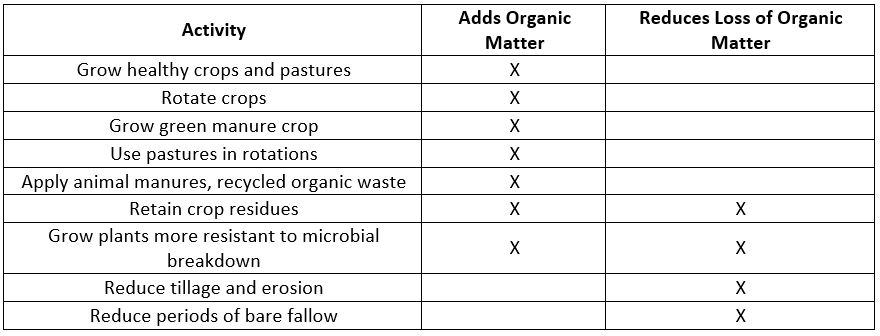
Adapt N
- Adapt N is a software tool for agronomists to help deliver exceptional in-field performance to growers. Users have total control of how to configure each field, whether flat rate or variable. This software is available to set up or fully integrate into other software systems. Adapt-N has combined advanced crop modeling, soil types, field management, and weather in order to increase grower profits.
Profit Zone Manager
- Profit zone manager places a dollar amount on every management decision giving you the power to analyze your fields’ financial performance at a higher resolution. Bringing profit and loss to each agronomic decision, PZM allows you to create management scenarios using your harvest data, as applied data, and crop budget. This generates a multiyear outcome by averaging all available years of a field’s data. See profit, return on investment, breakeven commodity price, breakeven yield increase, and production efficiency for each year of field data. Identify which areas of your field are performing well and which areas are costing you money.
Topography Mapping
- RTK based topography mapping maps the shape, altitude, and flow accumulation of your field. This allows you to properly map out tiles and drainage ways to best suit your field’s yield potential. Hand your book over to us at AgriVision and allow us to map water ways, best advise your drainage needs, and find problem areas where leaching occurs.
Soil Health Testing

For years we have been trained to only look at the chemical values in our soils and add more phosphorus or potassium depending on the soils deficiency. That amount of information is the equivalent to brush hogging with your tractor on a hot day and only staring at the fuel gauge. At some point and time, the tractor is going to overheat if you don’t watch the thermostat.
We know what levels of phosphorus (18-25 ppm), potassium (150-200 ppm), pH (6.5), and all other elements on a soil test “should be” at to bring us the best ROI. Is this the only information that we should be looking at to determine the performance of our field? The information that we get in a chemical test is important, but it needs to be tied together with other aspects. Below we have the three ways to evaluate soil and certain tests we can do to determine how good or bad the soil is in each category.
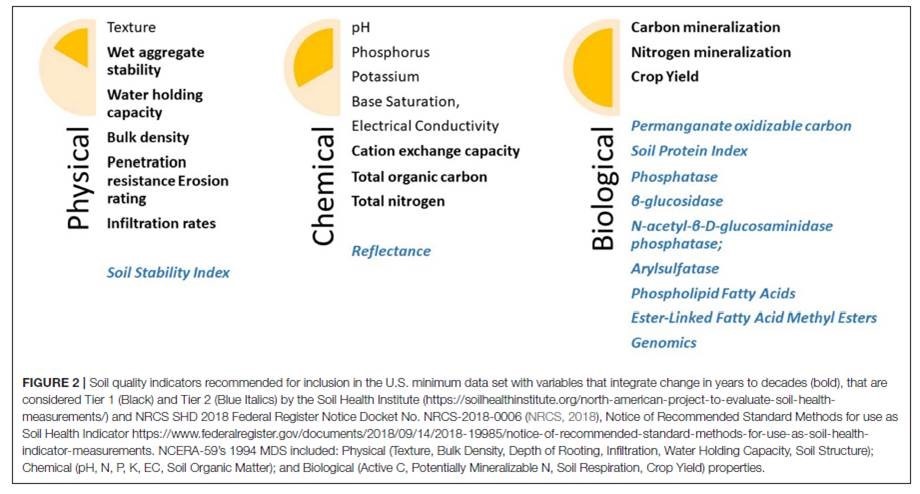
In a way to determine the physical and biological aspects of your soil AgriVision Solutions offers the Solvita Soil Health test. The Solvita Soil Health tests cover physical and biological measurements. The tests and uses are described below.
- CO2 Burst (CO2 Respiration): CO2 Burst is a Biological test. Measuring the amount of CO2 your soil puts out in a 24 hour period gives us an insight into how active the microbial population is in your soil. Just like human population in cities verse rural areas, there is more CO2 output in higher populated/more active areas. (Example: fields that are worked and have had salt based fertilizers applied to them for many years could have a 30-60 ppm; and a soil that is no-till along with getting cover crops and manure can be a 60-90 ppm.)
- SLAN (Soil Labile Amino Nitrogen): SLAN is a Biological test. Labile Amino Nitrogen measurements show us the soils ability to process and supply nitrogen to the plants. Pairing the SLAN and CO2 Burst tests together give us agronomists the ability to figure how profitable the soil will be at supplying all nutrients to the crops grown on it. (Example: similar to the CO2 Burst, fields that are worked and have had salt based fertilizers applied to them for many years could have a 70-120 ppm; and a soil that is no-till along with getting cover crops an manure can be a 90-225 ppm.)
- VAST (Volumetric Aggregate Stability Test): VAST is a Physical test that is influenced by the biology. By using our already dried soils in a rewetting process we compute a percentage based score. Comparing this score to other soils that have been previously tested in different management scenarios we can make recommendations on how to improve the structure or feel of your soil. (Example: soil that has been worked 3 or 4 times a year will commonly have a score around 15-20%; whereas a field of continuous no-till with cover crops or 3 and 4 rotations of crops could possibly be 40-60%.)
These three tests combined with the common chemical tests and yield data we can make a very good evaluation of what is going on in the soil, what are the yield limiting factors, and what can we do to turn those areas around within your budget in mind.
When farmers take out ground that has been in CRP or another form of long term grass land the soil tests are almost always “low” but the yield for the first few years is usually higher than normal row crop fields around it. What is the reason for this? Why is the chemical soil test low and yield high? And how does yield slowly decrease as we are adding fertilizer and increasing fertility levels? We like to think that we are helping that soil by adding fertilizers but are we really?
Before we had refrigeration, everyone used salts to store produce, store meat and cure meat. In order to understand what is happening to the soil we need to understand the use of salts first. Salt (Sodium Chloride) is used to slow or kill bacteria and microbes which in turn slows or stops the breakdown of proteins in the meat or produce. Most fertilizers have some percent of salts incorporated in with the nutrient. So along with fertility we are adding salts to the soil. Minute amounts of salts will not affect the process of your soils but applying salt-based nutrients for 20, 30, or even 70 years may have diverse affects. Each bacteria and microbe living in the soil have their job to do in processing nutrients in some form or another. These processes need to be taken into consideration when determining both your long term and short-term fertility programs. The table below show how many pounds of salt that is being applied per 100 pounds of common fertilizers. Now add that up for how many years these fertilizers have been spread on your ground.
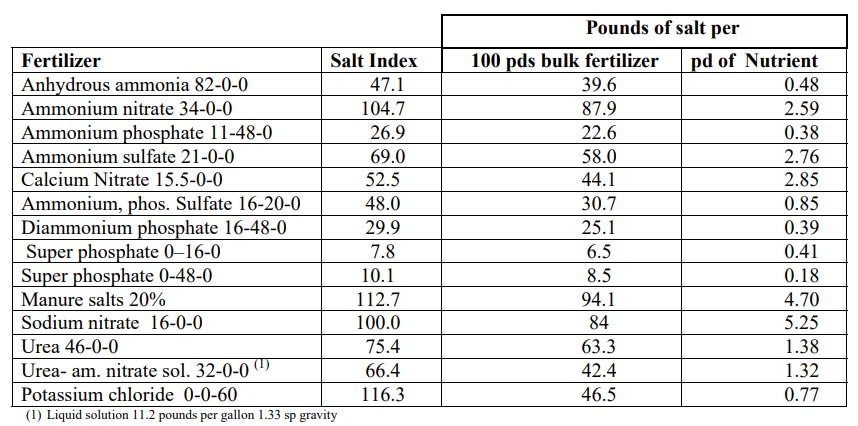
Fertilizer Salt Index graph is from the Central Arizona Salinity Study
What are we trying to achieve?
As explained earlier, soil health is only one aspect of the web we are trying to unravel and learn from to produce the most efficient crops possible. AgriVision Solutions wants to be here to help you in the field, any adjustment made to the planter closing system, auto steer, drainage system, or sprayer affects your yield for the coming year. The same goes for your entire operation. We have the agronomic understanding with all of these aspects in mind and still strive to research and learn more about certain techniques, soil structure, and new products. The whole other universe in the soil seems to be the thing that we as people understand the least. Even though our soil health research does not give us clear and direct answers, it definitely puts us on the right path to understand best management practices for the next generations.
